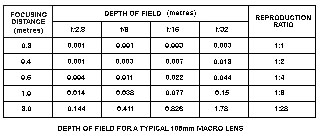Limited depth of field is an important consideration in macro photography. It essential to focus on the most important part of the subject, as elements just a millimetre closer or further away may be less than critically sharp. When photographing a small insect it is typically necessary to use a reproduction ratio of 1:2 or more. Depth of field may be as shallow as 5mm, and not sufficient to render the whole insect sharp. Depth of field increases with smaller apertures, but these imply increased exposure times and hence increased stability for camera and subject. One solution is to use flash. When used close-up, flash output from even modest equipment is likely to be very intense and hence make possible the use of apertures such as f/45 or f/64. A simple flashgun used at a normal macro distance can easily provide sufficient light for an aperture of f/32.
The table below gives typical figures for depth of field, at various reproduction ratios, for a 105mm macro lens. The figures are rounded for convenience and intended for illustrative purposes only. Check with the appropriate lens manufacturer for precise figures.

Depth of field can be optimized by using a number of simple techniques. The subject should be viewed from an angle where it is most likely to fit within the depth of field envelope. This might, for instance, be from the side of a long insect rather than head-on. Use the smallest aperture possible given the light available, and add flash if necessary. Also. make sure that best use is made of the depth of field available by focusing on the nearest and furthest points that must be rendered sharp, and locking the focus on a mid point. A depth of field preview facility can be used to check the final depth of field envelope although this action closes down the lens diaphragm and consequently darkens the image in the viewfinder. Where depth of field remains insufficient, decrease the reproduction ratio by moving back from the subject.
Another approach to obtaining increased depth of field is to use focus stacking, a digital technique described in this section. However other factors also have great significance. These include the nature of the subject, the ISO rating of the film or sensor, and the degree of stability that can be achieved for both the subject and the camera.






